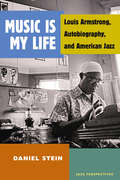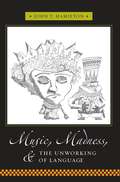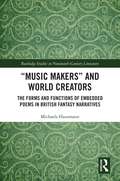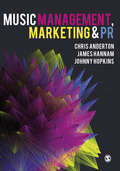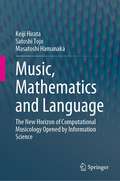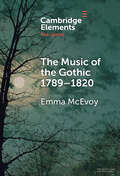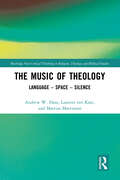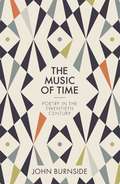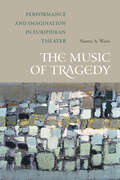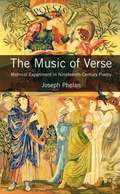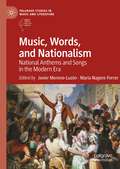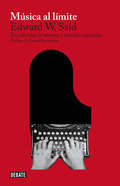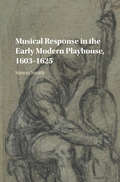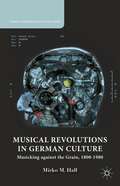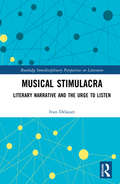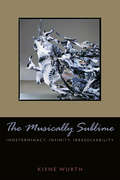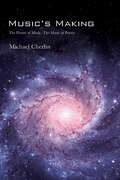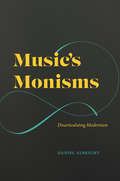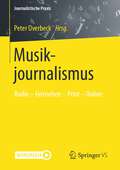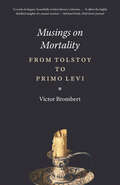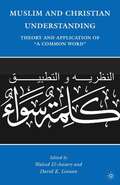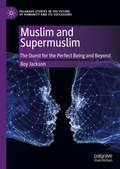- Table View
- List View
Music in the Georgian Novel
by Pierre DuboisMusic was an essential aspect of life in eighteenth-century Britain and plays a crucial role in the literary strategies of Georgian novels. This book is the first to investigate the literary representation of music in these works and explores the structural, dramatic and metaphorical roles of music in novels by authors ranging from Richardson to Austen. Pierre Dubois explores the meaning of 'musical scenes' by framing them within contemporary cultural issues, such as the critique of Italian opera or the theoretical shift from mimesis to the alleged autonomy and mystery of music. Focusing upon both eighteenth-century theories of music, and the way specific musical instruments were perceived in the collective imagination, Dubois suggests new interpretative perspectives for a whole range of novels of the Georgian era. This book will be of interest to a wide readership interested not only in literature, but also in music and cultural history at large.
Music Is My Life: Louis Armstrong, Autobiography, and American Jazz
by Daniel SteinMusic Is My Lifeis the first comprehensive analysis of Louis Armstrong's autobiographical writings (including his books, essays, and letters) and their relation to his musical and visual performances. Combining approaches from autobiography theory, literary criticism, intermedia studies, cultural history, and musicology, Daniel Stein reconstructs Armstrong's performances of his life story across various media and for different audiences, complicating the monolithic and hagiographic views of the musician. The book will appeal to academic readers with an interest in African American studies, jazz studies, musicology, and popular culture, as well as general readers interested in Armstrong's life and music, jazz, and twentieth-century entertainment. While not a biography, it provides a key to understanding Armstrong's oeuvre as well as his complicated place in American history and twentieth-century media culture.
Music, Madness, and the Unworking of Language (Columbia Themes in Philosophy, Social Criticism, and the Arts)
by John HamiltonIn the romantic tradition, music is consistently associated with madness, either as cause or cure. Writers as diverse as Kleist, Hoffmann, and Nietzsche articulated this theme, which in fact reaches back to classical antiquity and continues to resonate in the modern imagination. What John Hamilton investigates in this study is the way literary, philosophical, and psychological treatments of music and madness challenge the limits of representation and thereby create a crisis of language. Special focus is given to the decidedly autobiographical impulse of the late eighteenth and early nineteenth centuries, where musical experience and mental disturbance disrupt the expression of referential thought, illuminating the irreducible aspects of the self before language can work them back into a discursive system. The study begins in the 1750s with Diderot's Neveu de Rameau, and situates that text in relation to Rousseau's reflections on the voice and the burgeoning discipline of musical aesthetics. Upon tracing the linkage of music and madness that courses through the work of Herder, Hegel, Wackenroder, and Kleist, Hamilton turns his attention to E. T. A. Hoffmann, whose writings of the first decades of the nineteenth century accumulate and qualify the preceding tradition. Throughout, Hamilton considers the particular representations that link music and madness, investigating the underlying motives, preconceptions, and ideological premises that facilitate the association of these two experiences. The gap between sensation and its verbal representation proved especially problematic for romantic writers concerned with the ineffability of selfhood. The author who chose to represent himself necessarily faced problems of language, which invariably compromised the uniqueness that the author wished to express. Music and madness, therefore, unworked the generalizing functions of language and marked a critical limit to linguistic capabilities. While the various conflicts among music, madness, and language questioned the viability of signification, they also raised the possibility of producing meaning beyond significance.
“Music Makers” and World Creators: The Forms And Functions Of Embedded Poems In British Fantasy Narratives (Routledge Studies in Nineteenth Century Literature)
by Michaela HausmannMany works of fantasy literature feature a considerable number of embedded poems, some written by the authors themselves, some borrowed and transformed from other authors. Exploring the mechanisms of this mix and the interaction between individual poems and the overall narrative, this monograph analyses the various forms and functions of embedded poems in major works of fantasy literature. The choice of authors and texts shed light on the development of fantasy as a genre that frequently mixes prose and verse and thus continues the long tradition of prosimetric practices after the Romantic period. Not only does the analysis of the embedded poems allow for a new understanding of the individual works. It also promises insights into shared literary-historical roots, cross-influences between the authors and the role of the mix of poetry and prose for the imaginative and subversive potential of fantasy literature in general. Providing comprehensive case studies of the forms and functions of embedded poems in fantasy literature, this volume illuminates the emergence of modern fantasy and its impact on contemporary fantasy.
Music Management, Marketing and PR
by Chris Anderton James Hannam Johnny HopkinsThis book is your guide to the study and practice of music management and the fast-moving music business of the 21st century. Covering a range of careers, organisations, and practices, this expert introduction will help aspiring artists, managers, and executives to understand and succeed in this exciting sector. Featuring exclusive interviews with industry experts and discussions of well-known artists, it covers key areas such as artist development, the live music sector, fan engagement, and copyright. Other topics include: Managing contracts and assembling teams. Using data audits of platforms to adapt campaigns. Shaping opinions about music, musicians, events. How the music industry can be more diverse, inclusive, and equitable for the benefit of all. Working with venues, promoters, booking agents, and tour managers. Branding, sponsorship, and endorsement. Funding, crowdsourcing and royalty collection. Ongoing digital developments such as streaming income and algorithmic recommendation. Balancing the creative and the commercial, it is essential reading for students of music management, music business, and music promotion – and anybody looking to build their career in the music industries. Dr Chris Anderton, Johnny Hopkins, and James Hannam all teach on the BA Music Business at the Faculty of Business, Law and Digital Technologies at Solent University, Southampton, UK.
Music Management, Marketing and PR
by Chris Anderton James Hannam Johnny HopkinsThis book is your guide to the study and practice of music management and the fast-moving music business of the 21st century. Covering a range of careers, organisations, and practices, this expert introduction will help aspiring artists, managers, and executives to understand and succeed in this exciting sector. Featuring exclusive interviews with industry experts and discussions of well-known artists, it covers key areas such as artist development, the live music sector, fan engagement, and copyright. Other topics include: Managing contracts and assembling teams. Using data audits of platforms to adapt campaigns. Shaping opinions about music, musicians, events. How the music industry can be more diverse, inclusive, and equitable for the benefit of all. Working with venues, promoters, booking agents, and tour managers. Branding, sponsorship, and endorsement. Funding, crowdsourcing and royalty collection. Ongoing digital developments such as streaming income and algorithmic recommendation. Balancing the creative and the commercial, it is essential reading for students of music management, music business, and music promotion – and anybody looking to build their career in the music industries. Dr Chris Anderton, Johnny Hopkins, and James Hannam all teach on the BA Music Business at the Faculty of Business, Law and Digital Technologies at Solent University, Southampton, UK.
Music, Mathematics and Language: The New Horizon of Computational Musicology Opened by Information Science
by Keiji Hirata Satoshi Tojo Masatoshi HamanakaThis book presents a new approach to computational musicology in which music becomes a computational entity based on human cognition, allowing us to calculate music like numbers. Does music have semantics? Can the meaning of music be revealed using symbols and described using language? The authors seek to answer these questions in order to reveal the essence of music. Chapter 1 addresses a very fundamental point, the meaning of music, while referring to semiotics, gestalt, Schenkerian analysis and cognitive reality. Chapter 2 considers why the 12-tone equal temperament came to be prevalent. This chapter serves as an introduction to the mathematical definition of harmony, which concerns the ratios of frequency in tonic waves. Chapter 3, “Music and Language,” explains the fundamentals of grammar theory and the compositionality principle, which states that the semantics of a sentence can be composed in parallel to its syntactic structure. In turn, Chapter 4 explains the most prevalent score notation – the Berklee method, which originated at the Berklee School of Music in Boston – from a different point of view, namely, symbolic computation based on music theory. Chapters 5 and 6 introduce readers to two important theories, the implication-realization model and generative theory of tonal music (GTTM), and explain the essence of these theories, also from a computational standpoint. The authors seek to reinterpret these theories, aiming at their formalization and implementation on a computer. Chapter 7 presents the outcomes of this attempt, describing the framework that the authors have developed, in which music is formalized and becomes computable. Chapters 8 and 9 are devoted to GTTM analyzers and the applications of GTTM. Lastly, Chapter 10 discusses the future of music in connection with computation and artificial intelligence.This book is intended both for general readers who are interested in music, and scientists whose research focuses on music information processing. In order to make the content as accessible as possible, each chapter is self-contained.
The Music of Humanity: A Critical Study of Wordsworth's Ruined Cottage Incorporating Texts from a Manuscript of 1799—1800
by Jonathan WordsworthA careful analysis including biographical information.
The Music of the Gothic:1789–1820 (Elements in the Gothic)
by Emma McEvoyMusic plays an essential role in Gothic in the years 1789–1820, but it signifies very differently at the end of the period compared with the beginning. In the 1790s, the music of Gothic novels and plays is not Gothic music; it is celebratory, calming or transcendent rather than scary. By 1820, the music of Gothic is more likely to provoke shock, discomfort and unease. Melodrama brings about this change. Its ascendancy had long-lasting effects on the music of the Gothic more generally – in fiction and poetry, on the stage and the screen. The book considers work by writers including Ann Radcliffe, Matthew Lewis, Eliza Fenwick, Samuel Taylor Coleridge and James Boaden in conjunction with music by composers such as Michael Kelly, Stephen Storace and Samuel Arnold. Audio files of the music accompany the book.
The Music of Theology: Language – Space – Silence (Routledge New Critical Thinking in Religion, Theology and Biblical Studies)
by Andrew Hass Mattias Martinson Laurens ten KateThis book reconceives theology as a musical endeavour in critical tension with language, space and silence. An Overture first moves us from music to religion, and then from theology back to music – a circularity that, drawing upon history, sociology, phenomenology, and philosophy, disclaims any theology of music and instead pursues the music in theology. The chapters that follow explore the three central themes by way of theory, music and myth: Adorno, Benjamin and Deleuze (language), Derrida, Rosa and Nancy (space), Schelling/Hegel, Homer and Cage (silence). In overdubbing each other, these chapters work towards theology as a sonorous rhythm between loss and freedom. A Coda provides three brief musical examples – Thomas Tallis, György Ligeti, and Evan Parker – as manifestations of this rhythm, to show in summary how music becomes the very pulse of theology, and theology the very intuition of music. The authors offer an interdisciplinary engagement addressing fundamental questions of the self and the other, of humanity and the divine, in a deconstruction of modern culture and of its bias towards the eye over the ear. The book harmonizes three scholarly voices who attempt to find where the resonance of our Western conceptions and practice, musically and theologically, might resound anew as a more expansive music of theology.
The Music of Time: Poetry in the Twentieth Century
by John BurnsideA revelatory and deeply personal history of twentieth-century poetry by prize-winning poet and memoirist John BurnsidePoetry helps us to make sense of our world, transforming what the Russian poet Osip Mandelstam called the "noise of time" into a kind of music. The Music of Time is a unique history of twentieth-century poetry by one of today's most acclaimed poets, blending incandescent personal meditations with rare insights about a broad range of poets who distilled the essence of the moment, gave voice to our griefs and joys, and shaped our collective memory.Bringing together poets from times and places as diverse as Tsarist Russia, 1960s Harlem, and Ireland at the height of the Troubles, Burnside reveals how poetry responded to the dramatic events of the century while shaping our impressions of them. He takes readers from the trenches of World War I to a prison cell in Nazi Germany, and from Rilke's grave in the Swiss Alps to Dylan Thomas's Welsh seaside. His luminous narrative is woven through with insights into the poet's creative process as well as lyrical and thought-provoking digressions on topics ranging from marriage to the Kennedy assassination.A spellbinding work of literary history, The Music of Time reveals how poets engaged with the most important issues and events of the twentieth century, and bears personal witness to the beauty and power of an art form unlike any other.
The Music of Tragedy: Performance and Imagination in Euripidean Theater
by Naomi A. WeissThe Music of Tragedy offers a new approach to the study of classical Greek theater by examining the use of musical language, imagery, and performance in the late work of Euripides. Naomi Weiss demonstrates that Euripides’ allusions to music-making are not just metatheatrical flourishes or gestures towards musical and religious practices external to the drama but closely interwoven with the dramatic plot. Situating Euripides’ experimentation with the dramaturgical effects of mousike within a broader cultural context, she shows how much of his novelty lies in his reinvention of traditional lyric styles and motifs for the tragic stage. If we wish to understand better the trajectories of this most important ancient art form, The Music of Tragedy argues, we must pay closer attention to the role played by both music and text.
The Music of Verse
by Joseph PhelanThrough its recovery of the metrical principles underlying the work of some of the century's major poets, this study highlights the intricacy of the relation between the 'music' of verse and its meaning, and helping us to understand the way in which the ferment of metrical experiment eventually led to the emergence of free verse.
Music, Words, and Nationalism: National Anthems and Songs in the Modern Era (Palgrave Studies in Music and Literature)
by Javier Moreno-Luzón María Nagore-FerrerMusic, Words and Nationalism: National Anthems and Songs in the Modern Era considers the concept of nationalism from 1780 to 2020 through anthems and national songs as symbolic and representative elements of the national identity of individuals, peoples, or collectivities. The volume shows that both the words and music of these works reveal a great deal about the defining features of a nation, its political and cultural history, and its self-perception. The book takes an interdisciplinary approach that provides a better understanding of the role of national anthems and songs in the expression of national identities and nationalistic goals. From this perspective, the relationship between hymns and political contexts, their own symbolic content (both literary and musical) and the role of specific hymns in the construction of national sentiments are surveyed.
Música al límite: Tres décadas de ensayos y artículos musicales
by Edward W. SaidLos mejores textos de Edward Said sobre música, una de sus grandes pasiones. Música al límite reúne lo mejor de tres décadas de reflexiones de Edward Said sobre la música, una de sus grandes pasiones. Abarcando una gran variedad de compositores e intérpretes, Said analiza su contexto social y político, y ofrece perspectivas agudas y a menudo sorprendentes. Reflexiona sobre la censura de Wagner en Israel; la relación entre la música y el feminismo; y las obras de Beethoven, Bruckner, Rossini, Schumann o Stravinski, entre otros. Siempre elocuente, revelador y profundo, Música al límite refuerza la reputación de Said como uno de los intelectuales de referencia del siglo XX. Reseñas:«Hay pocos capaces de lograr con sus palabras que la música ilumine el mundo de aquellos que la crean y la escuchan. Said es uno de ellos.»Daily Telegraph «La brillante elocuencia de los escritos de Said nos recuerdaque con su muerte prematura hemos perdido a uno de nuestros más distinguidos críticos musicales.»Maynard Solomon «Sus textos sobre música e interpretación musical son, como mínimo, entretenidos e instructivos, siempre expresados con gran elegancia lingüística y, en el mejor de los casos, brillantes, originales e ingeniosos, cuajados de revelaciones inesperadas que solo él podía desvelar.»Daniel Barenboim «Edward Said era un apasionado de la música y poseía la rara capacidad de escribir sobre ella para el gran público con una inteligencia lúcida y penetrante.»Times Literary Supplement
Musical Response in the Early Modern Playhouse, 1603–1625
by Simon SmithPresupposing no specialist musical knowledge, this book offers a fresh perspective on the dramatic role of music in the plays of Shakespeare and his early seventeenth-century contemporaries. Simon Smith argues that many plays used music as a dramatic tool, inviting culturally familiar responses to music from playgoers. Music cues regularly encouraged audiences to listen, look, imagine or remember at dramatically critical moments, shaping meaning in plays from The Winter's Tale to A Game at Chess, and making theatregoers active and playful participants in playhouse performance. Drawing upon sensory studies, theatre history, material texts, musicology and close reading, Smith argues for the importance of music in familiar and less well-known plays including Antony and Cleopatra, Othello, The Revenger's Tragedy, Sophonisba, The Spanish Gypsy and A Woman Killed With Kindness.
Musical Revolutions in German Culture
by Mirko M. HallMusical Revolutions in German Culture explores the persistence of a critical-deconstructive philosophy toward musical production, consumption, and reception in Germany over the past two centuries. Drawing upon the cultural-revolutionary insights of Friedrich Schlegel, Walter Benjamin, Theodor W. Adorno, and Blixa Bargeld, this book investigates how radical musical discourses and practices engage sound as a powerful site of cultural creativity, critique, and resistance. Intellectual historian Mirko M. Hall shows how music, when intentionally situated within certain counterhegemonic aesthetic practices, can decisively transform everyday consciousness in the service of human freedom.
Musical Stimulacra: Literary Narrative and the Urge to Listen (Routledge Interdisciplinary Perspectives on Literature)
by Ivan DelazariThe title coinage of this book, stimulacra, refers to the fundamental capacity of literary narrative to stimulate our minds and senses by simulating things through words. Musical stimulacra are passages of fiction that readers are empowered to transpose into mental simulations of music. The book theorizes how fiction can generate musical experience, explains what constitutes that experience, and explores the musical dimensions of three American novels: William T. Vollmann’s Europe Central (2005), William H. Gass’s Middle C (2013), and Richard Powers’s Orfeo (2014). Musical Stimulacra approaches fiction’s music from a readerly perspective. Instead of looking at how novels forever fail to compensate for music’s physical, structural, and affective properties, the book concentrates on what literary narrative can do musically. Negotiating common grounds for cognitive audionarratology and intermediality studies, Musical Stimulacra builds its case on the assumption that, among other things, fiction urges us to listen—to musical words and worlds.
Musically Sublime: Indeterminacy, Infinity, Irresolvability
by Kiene Brillenburg WurthMusically Sublime rewrites musically the history and philosophy of the sublime. Music enables us to reconsider the traditional course of sublime feeling on a track from pain to pleasure. Resisting the notion that there is a single format for sublime feeling, Wurth shows how, from the mid eighteenth century onward, sublime feeling is, instead, constantly rearticulated in a complex interaction with musicality. Wurth takes as her point of departure Immanuel Kant's Critique of Judgment and Jean-François Lyotard's aesthetic writings of the 1980s and 1990s. Kant framed the sublime narratively as an epic of self-transcendence. By contrast, Lyotard sought to substitute open immanence for Kantian transcendence, yet he failed to deconstruct the Kantian epic. The book performs this deconstruction by juxtaposing eighteenth- and nineteenth-century conceptions of the infinite, Sehnsucht, the divided self, and unconscious drives with contemporary readings of instrumental music. Critically assessing Edmund Burke, James Usher, E.T.A. Hoffmann, Novalis, Friedrich Hölderlin, Arthur Schopenhauer, Richard Wagner, and Friedrich Nietzsche, this book re-presents the sublime as a feeling that defers resolution and hangs suspended between pain and pleasure. Musically Sublime rewrites the mathematical sublime as différance, while it redresses the dynamical sublime as trauma: unending, undetermined, unresolved.Whereas most musicological studies in this area have focused on traces of the Kantian sublime in Handel, Haydn, and Beethoven, this book calls on the nineteenth-century theorist Arthur Seidl to analyze the sublime of, rather than in, music. It does so by invoking Seidl's concept of formwidrigkeit ("form-contrariness") in juxtaposition with Romantic piano music, (post)modernist musical minimalisms, and Lyotard's postmodern sublime. It presents a sublime of matter, rather than form-performative rather than representational. In doing so, Musically Sublime shows that the binary distinction Lyotard posits between the postmodern and romantic sublime is finally untenable.
Music's Making: The Poetry of Music, the Music of Poetry
by Michael CherlinAs a work of musical theory, or meta-theory, Music's Making draws extensively on work done in philosophy and literary criticism in addition to the scholarship of musicologists and music theorists. Music's Making is divided into two large parts. The first half develops global attitudes toward music: emergence out of self and hearing through (drawing on Kabbalah and other sources), middle-voice (as discussed in philosophical phenomenology), liminal space (as discussed in literary theory), an ethics of intersubjectivity (drawing on Levinas), and character, canon, and metaleptic transformations (drawing chiefly on Harold Bloom). The second half embodies a search for metaphors, figurative language toward understanding music's endlessly variegated shaping of time-space. The musicians and scholars who inform this part of the book include Pierre Boulez, Gilles Deleuze, Anton Webern, Morton Feldman, and James Dillon. The book closes with an extended inquiry into the metaphors of horizontal and vertical experience and the spiritual qualities of musical experience expressed through those metaphors.
Music's Monisms: Disarticulating Modernism
by Daniel AlbrightDaniel Albright investigates musical phenomena through the lens of monism, the philosophical belief that things that appear to be two are actually one. Daniel Albright was one of the preeminent scholars of musical and literary modernism, leaving behind a rich body of work before his untimely passing. In Music’s Monisms, he shows how musical and literary phenomena alike can be fruitfully investigated through the lens of monism, a philosophical conviction that does away with the binary structures we use to make sense of reality. Albright shows that despite music’s many binaries—diatonic vs. chromatic, major vs. minor, tonal vs. atonal—there is always a larger system at work that aims to reconcile tension and resolve conflict. Albright identifies a “radical monism” in the work of modernist poets such as T. S. Eliot and musical works by Wagner, Debussy, Britten, Schoenberg, and Stravinsky. Radical monism insists on the interchangeability, even the sameness, of the basic dichotomies that govern our thinking and modes of organizing the universe. Through a series of close readings of musical and literary works, Albright advances powerful philosophical arguments that not only shed light on these specific figures but also on aesthetic experience in general. Music’s Monisms is a revelatory work by one of modernist studies’ most distinguished figures.
Musikjournalismus: Radio – Fernsehen – Print – Online (Journalistische Praxis)
by Peter OverbeckDieses Buch vermittelt die Grundlagen des Musikjournalismus. Erfahrene Praktiker informieren über die verschiedenen journalistischen Tätigkeiten – von der Programmgestaltung über die Musikkritik bis zur Moderation von Musiksendungen und Interviews mit Musikern in den Musiksparten von Klassik bis Pop. Die Besonderheiten in Radio, Fernsehen, Print und Online werden anhand zahlreicher Beispiele analysiert, die Funktion und der Einsatz von Musik sowie sprachliche, dramaturgische und gestalterische Mittel erörtert. Es gibt Tipps zum Berufsbild und zur Ausbildung und zu den vielfältigen Tätigkeiten.
Musings on Mortality: From Tolstoy to Primo Levi
by Victor Brombert“Elegant, beautifully written literary criticism, examining how eight major writers—‘From Tolstoy to Primo Levi’—dealt with death in their fiction.” —The Wall Street Journal“All art and the love of art,” Victor Brombert writes at the beginning of the deeply personal Musings on Mortality, “allow us to negate our nothingness.” As a young man returning from World War II, Brombert came to understand this truth as he immersed himself in literature. Death can be found everywhere in literature, he saw, but literature itself is on the side of life. With delicacy and penetrating insight, Brombert traces the theme of mortality in the work of a group of modern writers: Leo Tolstoy, Thomas Mann, Franz Kafka, Virginia Woolf, Albert Camus, Giorgio Bassani, J. M. Coetzee, and Primo Levi. Illuminating their views on the meaning of life and the human condition, Brombert ultimately, reveals that by understanding how these authors wrote about mortality, we can grasp the full scope of their literary achievement and vision.Winner of the Robert Penn Warren-Cleanth Brooks award for outstanding literary criticism.“Suffused with wisdom and argued with the strong hand of a weathered and feeling literary scholar. . . . It is hard to imagine such thematic criticism being done better than here. What a beautiful book.” —Thomas Harrison, author of 1910: The Emancipation of Dissonance“A brave and eloquent book.” — Peter Brooks, author of Henry James Goes to Paris“The simplicity and directness of Brombert’s style gives his discussion of the philosophical and aesthetic underpinnings of the works under scrutiny great clarity.” —Publishers Weekly“Brombert’s eloquently written book is for serious lovers of literature.” —Library Journal
Muslim and Christian Understanding
by Waleed El-Ansary David K. LinnanThis book explores 'A Common Word Between Us and You', a high-level ongoing Christian-Muslim dialogue process. The Common Word process was commenced by leading Islamic scholars and intellectuals as outreach in response to the Pope's much criticized Regensburg address of 2007.
Muslim and Supermuslim: The Quest for the Perfect Being and Beyond (Palgrave Studies in the Future of Humanity and its Successors)
by Roy JacksonThis book looks to the rich and varied Islamic tradition for insights into what it means to be human and, by implication, what this can tell us about the future human. The transhumanist movement, in its more radical expression, sees Homo sapiens as the cousin, perhaps the poorer cousin, of a new Humanity 2.0: ‘Man’ is replaced by ‘Superman’. The contribution that Islam can make to this movement concerns the central question of what this ‘Superman’ – or ‘Supermuslim’ – would actually entail. To look at what Islam can contribute we need not restrict ourselves to the Qur’an and the legal tradition, but also reach out to its philosophical and literary corpus. Roy Jackson focuses on such contributions from Muslim philosophy, science, and literature to see how Islam can confront and respond to the challenges raised by the growing movement of transhumanism.

